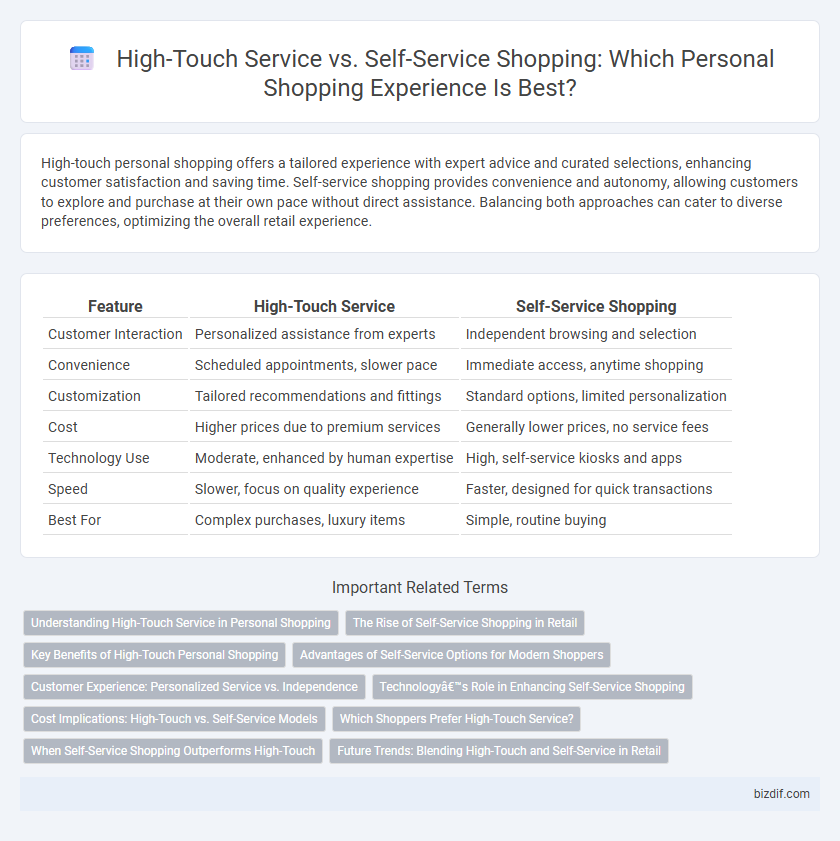High-touch personal shopping offers a tailored experience with expert advice and curated selections, enhancing customer satisfaction and saving time. Self-service shopping provides convenience and autonomy, allowing customers to explore and purchase at their own pace without direct assistance. Balancing both approaches can cater to diverse preferences, optimizing the overall retail experience.
Table of Comparison
| Feature | High-Touch Service | Self-Service Shopping |
|---|---|---|
| Customer Interaction | Personalized assistance from experts | Independent browsing and selection |
| Convenience | Scheduled appointments, slower pace | Immediate access, anytime shopping |
| Customization | Tailored recommendations and fittings | Standard options, limited personalization |
| Cost | Higher prices due to premium services | Generally lower prices, no service fees |
| Technology Use | Moderate, enhanced by human expertise | High, self-service kiosks and apps |
| Speed | Slower, focus on quality experience | Faster, designed for quick transactions |
| Best For | Complex purchases, luxury items | Simple, routine buying |
Understanding High-Touch Service in Personal Shopping
High-touch service in personal shopping emphasizes personalized attention and tailored recommendations, creating a unique shopper experience through direct interaction with knowledgeable consultants. This approach leverages detailed customer profiling and real-time feedback to deliver customized product selections and styling advice, enhancing satisfaction and loyalty. Understanding high-touch service involves recognizing its ability to combine expert insights and emotional connection, distinguishing it from self-service models that prioritize convenience and efficiency over personal engagement.
The Rise of Self-Service Shopping in Retail
Self-service shopping in retail has surged due to advancements in digital technology and consumer demand for convenience, allowing shoppers to browse, select, and pay independently through mobile apps, kiosks, and online platforms. Retailers like Amazon and Walmart have integrated AI-driven personalization and seamless checkout experiences, significantly reducing the need for high-touch interactions. This shift optimizes operational efficiency while catering to tech-savvy customers who prioritize speed and autonomy over traditional, personalized service.
Key Benefits of High-Touch Personal Shopping
High-touch personal shopping offers tailored recommendations and expert guidance, enhancing customer satisfaction through personalized attention. It creates a seamless, stress-free buying experience by anticipating customer needs and preferences. This service fosters stronger customer relationships, boosting brand loyalty and repeat purchases.
Advantages of Self-Service Options for Modern Shoppers
Self-service shopping offers modern consumers convenience and control, allowing them to browse and purchase products at their own pace without waiting for assistance. Advanced technologies like intuitive self-checkout systems, mobile apps, and AI-powered recommendations streamline the shopping experience, reducing transaction time. These options also provide 24/7 accessibility, catering to busy lifestyles and enabling quick decision-making with minimal interaction.
Customer Experience: Personalized Service vs. Independence
High-touch service in personal shopping delivers a tailored customer experience through expert guidance and customized product recommendations, enhancing satisfaction and loyalty. Self-service shopping emphasizes customer independence, allowing shoppers to explore products at their own pace with minimal assistance, fostering convenience and control. Balancing personalized service with the freedom of self-navigation defines modern retail strategies aimed at optimizing overall customer experience.
Technology’s Role in Enhancing Self-Service Shopping
Technology significantly transforms self-service shopping by integrating AI-powered chatbots, augmented reality (AR) fitting rooms, and personalized recommendation algorithms, enabling customers to enjoy a tailored experience without direct human assistance. Mobile apps and intuitive kiosks streamline product search and checkout processes, reducing wait times and enhancing convenience. These innovations empower consumers to make informed decisions independently while maintaining the efficiency and engagement typically associated with high-touch service.
Cost Implications: High-Touch vs. Self-Service Models
High-touch personal shopping services typically incur higher operational costs due to personalized assistance, extended interaction time, and specialized staff training, which often results in premium pricing for consumers. In contrast, self-service shopping models reduce overhead expenses by minimizing human involvement, leveraging digital interfaces, and streamlining processes, thereby offering lower price points. Retailers must balance investment in customer engagement with cost-efficiency to determine the optimal model for their target market and profitability goals.
Which Shoppers Prefer High-Touch Service?
High-touch service appeals primarily to shoppers seeking personalized guidance, tailored recommendations, and an elevated shopping experience, often including luxury goods consumers and those purchasing complex or high-value items. These shoppers prioritize expert advice, one-on-one interactions, and convenience, typically found in boutique stores, premium brands, or specialty retailers. Demographic groups such as affluent professionals, aging consumers, and time-constrained individuals commonly prefer high-touch shopping over self-service options.
When Self-Service Shopping Outperforms High-Touch
Self-service shopping outperforms high-touch service in scenarios where convenience and speed are prioritized, such as grocery or retail purchases involving routine or low-involvement items. Automated checkouts, mobile apps, and online platforms streamline transactions, reducing wait times and operational costs. Consumers seeking efficiency and control benefit from seamless interfaces and instant access to product information without the need for personalized assistance.
Future Trends: Blending High-Touch and Self-Service in Retail
Future retail trends emphasize a hybrid model blending high-touch personalized service with efficient self-service technologies, enhancing customer experience and satisfaction. Advanced AI-driven chatbots, virtual fitting rooms, and augmented reality tools empower shoppers with autonomy while maintaining the option for expert assistance when needed. This seamless integration optimizes operational efficiency and caters to diverse consumer preferences in personal shopping.
High-touch service vs Self-service shopping Infographic

 bizdif.com
bizdif.com